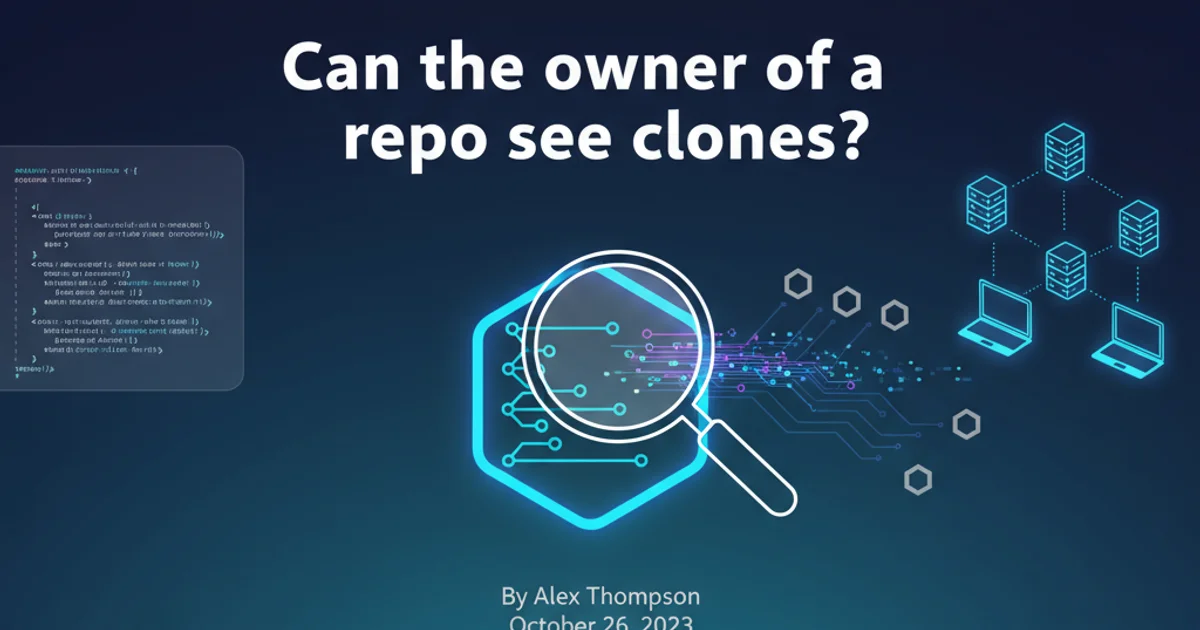Can the owner of a repo see clones?
Categories:
Can a GitHub Repository Owner See Who Cloned Their Repo?

Explore the visibility of repository clones on GitHub, understanding what data is accessible to owners and what remains private.
A common question among developers and repository owners on platforms like GitHub is whether they can track who clones their repositories. The act of cloning a repository creates a local copy of the code, enabling developers to work on it independently. This article delves into GitHub's policies and features to clarify what information, if any, is visible to a repository owner regarding clone activity.
Understanding GitHub's Clone Visibility
GitHub, by design, prioritizes user privacy for actions that do not directly modify the repository's state. Cloning a repository is generally considered a read-only operation that happens on the user's local machine. Therefore, GitHub does not provide repository owners with a direct list or log of individual users who have cloned their repository. This applies to both public and private repositories.
What GitHub Does Track: Clone Traffic
While individual clone identities are not revealed, GitHub does provide repository owners with aggregated data about clone activity. This information is available through the repository's 'Insights' tab, specifically under 'Traffic'. The 'Traffic' graph shows the total number of clones and unique cloners over a specific period (e.g., 14 days). This data is anonymous and does not identify specific users.
flowchart TD
A[User Initiates Clone] --> B{GitHub Server}
B --> C[Repository Data Transferred]
C --> D[Local Copy Created]
D --X E[Owner Sees User ID]
B --> F[Aggregated Clone Count]
B --> G[Aggregated Unique Cloner Count]
F & G --> H[Repository Insights (Traffic)]
H --> I[Owner Views Anonymous Metrics]
style E fill:#f9f,stroke:#333,stroke-width:2px
style D fill:#fff,stroke:#333,stroke-width:2px
style C fill:#fff,stroke:#333,stroke-width:2px
style B fill:#fff,stroke:#333,stroke-width:2px
style A fill:#fff,stroke:#333,stroke-width:2px
style F fill:#fff,stroke:#333,stroke-width:2px
style G fill:#fff,stroke:#333,stroke-width:2px
style H fill:#fff,stroke:#333,stroke-width:2px
style I fill:#fff,stroke:#333,stroke-width:2pxFlowchart illustrating GitHub's clone tracking mechanism, highlighting the anonymity of individual cloners.
Why This Anonymity Matters
The anonymity of individual cloners is a crucial aspect of GitHub's privacy model. It encourages developers to explore and experiment with code without fear of being tracked or monitored for simply downloading a repository. This fosters a more open and collaborative environment, especially for public projects. If every clone were logged and visible, it could deter users from exploring code, potentially hindering adoption and contribution to open-source projects.
Alternative Ways to Gauge Interest (Indirectly)
While direct clone tracking is not available, repository owners can gauge interest and engagement through other metrics and interactions:
- Stars: A direct indicator of appreciation and interest in a repository.
- Forks: When a user forks a repository, it creates a copy under their own GitHub account, which is publicly visible.
- Watchers: Users who 'watch' a repository receive notifications for activity, indicating active interest.
- Issues and Pull Requests: Direct engagement through bug reports, feature requests, and code contributions.
- Discussions: If enabled, discussions provide a forum for community interaction and feedback.
These metrics offer a more holistic view of a repository's impact and community engagement than individual clone counts ever could.
git clone https://github.com/owner/repo.git
Standard command to clone a GitHub repository.